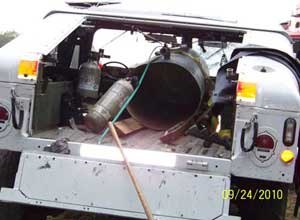
Insufficient funding awareness, inappropriate or missing parts in self-made water-delivery system also contributed to Ryan Seitz's death
A self-made water-delivery system with inappropriate parts caused a pressurized water tank to explode during a brush fire, killing one firefighter and injuring another, according to a NIOSH report.
A lack of training and written operating policies and procedures also contributed to the accident last year, investigators found.
Volunteer Firefighter Ryan Seitz, of the McArthur, Ohio, Fire Department, was fighting a brush fire on Sept. 26 when the force of the explosion dislodged the hose reel, which struck and killed him.
The department was one of nine called to the scene of the large rural grass fire. But vehicles and fences separated the crew from the fire line, so while three firefighters began raking a fire break, the rest drove to other areas and began extinguishing hot spots with a self-made, 120-gallon pressurized water tank, the report said.
Despite a burst hose and inadequate water pressure on the system, the firefighters did not report any warning noises or physical changes.
When the water tank exploded, the victim was thrown backward about 20 feet by the hose reel and killed instantly, investigators found The firefighter operating the hose line nozzle was knocked down by the force but was not seriously injured, and two others escaped injury.
The system did not have a safety release valve for over-pressurization, and its pressure gauge was not designed to be used in such a system, according to the report, which was released Oct. 6.
The report cites this as well as inappropriate system components as contributing factors in the death. Also, it was found that the firefighters had limited training and few written operating policies and procedures, especially regarding how to use the equipment.
The department may have built its own water-delivery system because of a lack of resources and programs, so NIOSH asks that fire departments be more aware of alternative funding, such as grants.
Because the fire department took a few shortcuts (parts of the water-delivery system were not intended to be used that way, and self-made equipment does not always meet safety standards), NIOSH recommends that fire departments use only equipment that is properly designed and safe for its intended use.
"While it is important that fire departments seek constant improvements and upgrades to their fire apparatus and equipment," the report said. "Some departments may not have the resources or programs to replace or upgrade their apparatus and equipment as often as they should."
NIOSH also suggests that fire departments should provide training on safe operation of equipment, including the 1986 military Humvee used to transport the water tank.
"The fire department did hold a number of hands-on training sessions to familiarize fire fighters with the water delivery system," the report said, "and the number of times that the Humvee was used by the fire department was documented."
In cases like these, fire departments might benefit from hiring a technical consultant with specific knowledge in the type of equipment in order to develop safe operating procedures and training plans.
Copyright © 2024 FireGrantsHelp.com. All rights reserved.
